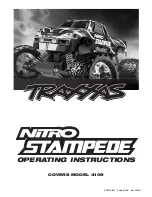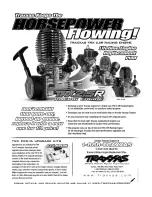
8
If richening the fuel mixture to bring the temperature down to
270° F results in poor, sluggish performance (engine never cleans
out) then return the engine back to a satisfactory state of tune based
on how it sounds and performs (always with a visible stream of blue
smoke coming from the exhaust). If engine temperature is exceeding
270° F with proper cooling and no signs of abnormal running, then
avoid running the engine at its maximum lean setting. Watch closely
for any signs of overheating. Richen the fuel mixture slightly to
provide a safety margin of additional cooling lubrication.
Symptoms of overheating include:
Steam or smoke coming from the engine (not exhaust).
Hesitation or stalling during acceleration.
Popping or clattering sound when decelerating detonation).
Fluctuating idle speed.
ADJUSTMENTS
Toe-in
Geometry and alignment specs play an important role in your
truck’s handling, so take the time to set them correctly. Set the
steering trim on your transmitter to neutral. Now, adjust your
tie rods so that both wheels are pointing straight ahead and
are parallel to each other (0 degrees toe-in). This will ensure the
same amount of steering in both directions. If you run out of
adjustment, then the steering servo will have to be re-centered
(see “centering your servos” on page 9).
For increased stability
add 1-2 degrees of toe-in to each front wheel. Use the
turnbuckles to adjust the alignment.
Camber
The camber angle of both the front and rear wheels can be
adjusted with the camber rods (upper turnbuckles). Use a square
or right-angle triangle to set the camber accurately. Adjust the
front wheels to 0 degrees of camber (wheel perpendicular to
the ground). In the rear, adjust the wheels to 1 to 2 degrees of
negative camber. These adjustments should be set with the truck
positioned at its normal ride height.
Shocks
The four shocks on Nitro Stampede
have the most influence on its handling.
Whenever you rebuild your shocks, or
make any changes to the pistons, springs
or oil, always do it carefully and in pairs
(front or rear). Piston head selection
depends on the range of oil viscosities
that you have available. For example,
using a two-hole piston with a lightweight
oil will, at one point, give you the same
dampening as a three-hole piston with
heavier oil. We recommend using the two-
hole pistons with a range of oil viscosities
from 10W to 50W (available from your hobby shop). The thinner
viscosity oils (30W or less) flow more smoothly and are more
consistent, while thicker oils provide more dampening.
Use only
100% pure silicone shock oil to prolong seal life.
The ride height for Nitro Stampede can be adjusted by adding or
removing the clip-on spring pre-load spacers. Instead of adding
spacers to increase stiffness, use stiffer springs. Adjust the ride
height so that the suspension arms are slightly above being parallel
to the ground. Observe how the Nitro Stampede handles in turns.
If it is picking up the inside rear wheel in hard turns, then stiffen
the front suspension. If it is picking up the inside front wheel in
hard turns, then stiffen the rear suspension. Proper set-up will
add stability and help prevent roll-overs.
Gear Ratios
A unique Nitro Stampede feature is the ability to change the gear
ratios. The final drive ratio of the gearbox is 3.75 to 1. Use the
following formula to calculate the overall ratio:
Nitro Stampede comes with a 66-tooth spur gear and a 18-tooth
pinion (clutch bell) gear. This combination will provide the best
overall acceleration and top speed. If you want more acceleration
and less top speed, then use a smaller clutch bell gear (fewer
teeth). For more top speed, use a larger clutch bell gear.
adjusting the Slipper Clutch
The Nitro Stampede features an adjustable slipper clutch on the
spur gear to protect the drivetrain from sudden shock loads (such as
landing off of jumps with the engine at full throttle). Under normal
conditions the slipper clutch should not slip. Before adjusting the
slipper clutch, turn the model off. Do not adjust the slipper clutch
while the engine is running.
Use the supplied wrench to tighten the slipper nut (clockwise) until
it stops and then back the nut out 1/4 of a turn. If you notice any
Positive camber
Negative camber
Toe-in
PRE-lOaD
SPaCERS
Remove the rubber exhaust pipe
and the tuned pipe. Remove the
electric starter drive. Loosen the four
3x8mm cap-head screws which hold
the slotted adjusting plates to the
engine mount.
Remove the 4mm nylon locknut and
the spring from the slipper clutch. Try
to remove the slipper clutch as one
assembly by holding the pressure
plates together with your thumb and
index finger.
Remove the large E-clip on the clutch
shaft and the clutch bell gear. Remove
the ball bearings and install them in
the new clutch bell gear. Reinstall
the clutch bell gear and E-clip. Note:
Smaller clutch bell gears use smaller
ball bearings. Refer to your parts list
for the correct bearings. Reinstall the
spur gear on the top shaft and secure
it with the 4mm locknut.
Slide a strip of thin note paper
between the spur gear and the clutch
bell gear. Push the clutch bell gear
against the spur gear and tighten
the 3x8mm adjusting plate screws.
Remove the paper and the gear mesh
should be correctly adjusted.
Changing the Clutch Bell and Spur Gears
Number of
Spur
gear teeth
Number of
Clutch Bell
gear teeth
x 3.75
Final drive ratio
Содержание Nitro Stampede
Страница 1: ...OPERATING INSTRUCTIONS COVERS MODEL 4109 KC0532 R01 Part 4199X Rev 090731...
Страница 15: ......

































